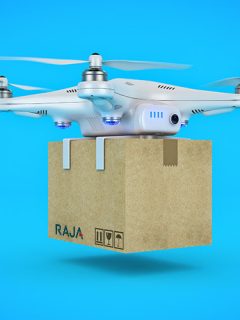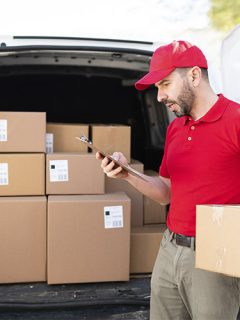When shipping products, many elements must be taken into account: size and weight of your products for sale, proper packaging, fixing and securing of the package…
That’s why we want to give you a 6-step checklist so that you can pack your packages perfectly, from A to Z. The key: to achieve an optimal experience for your customer.
The key: to achieve an optimal experience for your customer. You must send a package that arrives in good condition and that is pleasant to open, so you will also reduce incidents with carriers and with your customers.
- Step #1: Ask yourself the right questions
- Step # 2: Choose your packaging package
- Step #3: Protect your products
- Step #4: Group your products
- Step #5: Secure the package closed
- Step # 6: Ship the package
Step #1: Ask yourself the right questions
Packing your products well seems very simple, but in reality there are many decisions to make. A well-wrapped package requires asking yourself some essential questions before shipping your products. Here is a checklist to help you with this task:
- What: What are you shipping?
- Where: Where are your products being shipped?
- When: When do they need your products?
- How: How do you plan to ship: By carrier, by post?
- How much: How many products do you put per package?
- Why: Why do you want to use this type of box?
Step # 2: Choose your packaging package
This first step partly answers the question: “What are you going to send?” The wrong choice of packaging can have negative consequences on the condition in which your package will arrive: a sagging and damaged box can disappoint your customer.
To avoid this, you need to think about the type of packaging on the one hand and its size on the other.
what type of packaging should you choose?
This question determines the nature of the packaging you will use: a fragile product requires strong packaging, whereas an unbreakable product (clothing, for example) can be shipped in a plastic bag.
The choice is wide: box, bag, tube, envelope… It is up to you to find the packaging that best suits your e-commerce.
There are several qualities of resistance, which are determined according to the weight and type of product: single, double or triple channel box. Always bear in mind that between your company and your customer, thepackages will be handled several times, stacked, loaded and unloaded with more or less care!
Think about specific packaging if your products are extremely fragile: for example, bottles, which are often damaged during shipping, can be put in special bottle boxes, as can electronic products.
Consult with your transport providers: Find out about the climatic conditions in which your package will be transported. This may affect the packaging you have chosen or even the products it contains. Consider putting a moisture-proof pouch in your package.
what size of packaging should you choose?
A well-packed and protected package requires a box size that is appropriate for the product.
- If the cardboard box is too large, you run the risk of putting too much protective packaging or your product becoming loose and arriving damaged.
- If it is too small, it may open during transport.
So make sure you choose packaging that is as close as possible to the dimensions of your products.
If you choose to ship your products in a cardboard box, try our 1-click tool to find the most suitable box format for your products.

Expert tip: If you send your parcels by express and international mail, take a look at our tips forchecking the volumetric weight of your parcels. This is a billing method that can quickly increase your transport costs if you don’t optimise the size of your packaging.
Successfully packing a package also involves choosing a suitable stuffing solution
Step #3: Protect your products
You have chosen a packaging with the right dimensions, strong enough to protect the product. But that’s not all, you need to secure the product in the box.
For this, there are different types of protection: kraft paper, bubble wrap, air bags, foam, film…

Once again, ask the question about the nature of the product to be shipped:
- If the object is fragile, choose an effective padding and protection packaging, such as bubble wrap;
- If the object is not fragile, but risks being damaged by hitting the corners of the carton, opt for a cushioning solution, such as kraft paper or air bags.
Make sure to fill the empty spaces in your packaging as much as possible.
how to protect sensitive products?
- Electronic products are sensitive and therefore require anti-static cushioning.
- Finally, some surfaces are more likely to be scratched and require foam protection.
Discover more protection solutions for your products in our section.
Step #4: Group your products
There are several cases: you can have a single delicate product to pack, or several products to put in the same package.
In the latter case, you can use the products to link them together according to their weight or shape: the heaviest object should be placed first, at the bottom of the box so as not to crush the others. Then distribute the other products around the heavy object and on top.
Expert tip: if your package contains several products and you want the heaviest product to remain at the bottom, you should label the top of the box to help the carriers.
Crucial step in the success of a package: secure sealing
Step #5: Secure the package tightly closed
Now that your product is in the proper packaging, protected by effective cushioning, you can close your package. It seems obvious, but there are a few rules to follow.
Add tape, you can close the box in different ways using a roll of tape:
- U-shaped: for lightweight products.
- Combining L and U: for transporting heavy products.
- In H: a very secure method suitable for all products.

> Read also: “Good practices for the use of adhesive tape”
Step #6: Send the package
The main thing is done, the package is well packed, protected and closed, now it must arrive safely in good condition! To do this, make sure to place the shipping labels as follows:
- The document holder, recipient and sender addresses should be clearly visible, as well as the barcode on the receipt;
- Think of labels such as “Fragile” or “Do not stack”, so that the carrier can take some precautionary measures during delivery.
The package is now ready to be shipped. Thanks to the good care taken with the choice of your packaging, your customer will experience a happy unpacking moment and… they will certainly unbox your product on social media to recommend it!
The 6 key steps to remember:
- Ask the right questions before wrapping a product: what, where, when, how… This will save you time when preparing orders.
- Consider the type and size of the packaging of your parcel. Take into account the size, weight, fragility of the products to be shipped, as well as the volumetric billing system, to optimise your packaging.
- Select the right protection and securing system, depending on the weight and fragility of your product.
- Arrange the products inside your package so that they cannot collide and are stable.
- Close the package with the appropriate adhesive tape.
- Correctly attach the necessaryshipping labels for safe transport.















